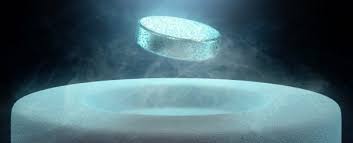Superconductivity has long been the Holy Grail of materials science. Superconductive materials have the ability to convey electricity with next to no resistance. This decreases energy loss, making energy conveyance a lot more efficient – which has implications for pretty much any technology, as long as it uses electric energy. Which pretty much covers a wide range of technology, from personal devices like smartphones, to medical applications, to transportation, to the power grid.

Source: Science Alert
Unfortunately, superconductivity so far has only occurred at ultracold temperatures (or under extreme pressure), which means it has had limited application when it came to everyday usage. You’re usually not using your smartphone, undergoing an MRI, taking the train, or operating the power grid when it’s hundreds of degrees below zero. In other words, cold that’s a lot colder than the normal, run of the mill frigid winter weather we regularly experience in the Syracuse, NY environs.
Then, a few weeks ago, came an announcement of a superconductor developed at the University of Rochester that could deliver on the superconductivity promise.
The new superconductor consists of lutetium, a rare earth metal, and hydrogen with a little bit of nitrogen mixed in. It needs to be compressed to a pressure of 145,000 pounds per square inch before it gains its superconducting prowess. That is about 10 times the pressure that is exerted at the bottom of the ocean’s deepest trenches.
The team at Rochester started with a small, thin foil of lutetium, a silvery white metal that is among the rarest of rare earth elements, and pressed it between two interlocking diamonds. A gas of 99 percent hydrogen and 1 percent nitrogen was then pumped into the tiny chamber and squeezed to high pressures. The sample was heated overnight at 150 degrees Fahrenheit, and after 24 hours, the pressure was released.
About one-third of the time, the process produced the desired result: a small vibrant blue crystal. (Source: NY Times)
Of course, your smartphone doesn’t operate at “the bottom of the ocean’s deepest trenches.” But this result represents a radical improvement over the results found earlier by the same Rochester team, which is led by Professor Ranga Dias. Those results, reported in 2020, were achieved at pressure “akin to the crushing forces found several thousand miles deep within the Earth.”
And as for the latest results only being produced one-third of the time, the power grid can’t rely on a process that only works that infrequently. Nor can your smartphone, for that matter.
Still, the Rochester team appears to be on a promising track for further research, suggesting that a superconductor that “works at ambient room temperatures and at the usual atmospheric pressure of 14.7 pounds per square inch” may well be within reach.
That’s the good news.
The not so good news is a cloud of controversy hovering over this latest finding, a controversy stemming from the 2020 report by the same team, which has since been retracted. Scientists are weighing in on this issue, from those who discount the controversy to those skeptics who cast full doubt on the latest findings. Most of those responding seem to be in the this is a great result, IF category.
“If this is real, it’s a really important breakthrough,” said Paul C.W. Chu, a professor of physics at the University of Houston who also was not involved with the research.
However, the “if” part of that sentiment swirls around Dr. Dias, who has been dogged by doubts and criticism, and even accusations by a few scientists that he has fabricated some of his data. The results of the 2020 Nature paper have yet to be reproduced by other research groups, and critics say that Dr. Dias has been slow to let others examine his data or perform independent analyses of his superconductors.
The decision to retract the 2020 paper was made by Nature editors, not by Dias and his co-authors, who objected to the retraction. That earlier paper has since been revised and is currently under review.
In any case, other researchers may be able to reproduce the experiment, which is viable because “the new lutetium-based material is superconducting at much lower pressures”, thus easier to replicate. And Professor Dias says that he would like to offer information on making the compound, and to share samples. However, there are some intellectual property issues standing in the way. Dias “has founded a company, Unearthly Materials, that plans to turn the research into profits.”
Researchers involved in this discovery understandably want to be compensated for their work, but that will rest on whether this latest attempt at superconductivity turns out to be the real deal. Hopefully, it is, as this could be a real game-changer when it comes to conveying electricity.
———————————————————————————————————–
Other articles on this topic you might be interested in: “Room Temperature Superconductivity Claimed,” published by Spectrum IEEE, and “Controversy Surrounds Blockbuster Superconductivity Claim” which appeared in Scientific American.
